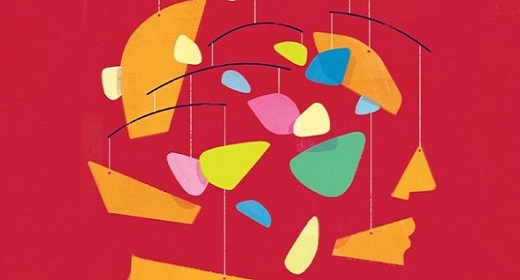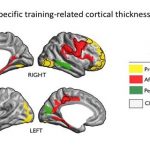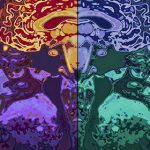by Julie Beck: Intimate videos of whispering and tapping fingernails cause pleasurable tingles, or ASMR, for some…

I am sitting at my desk in a nearly empty office on a December evening, feeling the sort of directionless melancholy that tends to take hold as the holiday season sets in, listening to a video of a gentle Russian woman whispering in my ear about how much she cares about my relaxation.
“You are appreciated,” she says, making scratching noises into a microphone so it sounds like she’s scratching my head. “I would like to protect you, to comfort you, to help you relax and forget about your trouble, whatever it is.”
I’ve got to be honest, it feels like a pretty weird and lonely thing to do.
But the video doesn’t work on me the way it’s supposed to. For many of her fans, Maria’s voice causes a sensation the Internet has dubbed ASMR—autonomous sensory meridian response. Those who get ASMR describe the experience as a tingling inside their heads, or a head rush. Sometimes the sensation extends down their backs or limbs. It’s often referred to as a brain-gasm, but counterintuitively, it’s also supposed to be relaxing, a mellow feeling. Some people watch the videos to help them sleep at night. And even without the tingles, it is sort of relaxing, if you can get past the dissonance of someone whispering in your ear while you scroll through Twitter in your cubicle, or whatever.
Aside from whispering, some of the other things that can trigger the sensation include tapping or scratching sounds, the sound of rain, or white noise. And it’s not just sounds: People report getting ASMR when getting a haircut, or an ear exam—any kind of close, personal attention.
“Whenever they had lice checks in elementary school, I would feel very relaxed, and would have the tingling sensation run from my head and down my back,” Lee, who works for an advertising agency in New York City, says of her first ASMR experience.
For John Skinner, a 23-year-old tutor in Chicago, his introduction to ASMR came from famously-fro’d TV painter Bob Ross.
“Every time I watched it, I would just completely zone out… I guess I wouldn’t really call it sleepy, more just like very, very mellow,” he says. And he’s not the only one—the subreddit for ASMR lists Bob Ross under “Common Triggers.”
Some people prefer accented voices—Maria is Russian, and moved to the U.S. in 2006. When she heard I was interviewing Maria (YouTube name “GentleWhispering”), Lee got excited. “She’s my favorite,” Lee said. “It’s something about the way she pronounces consonants. Her P’s are like cushiony pillows.”
Maria says that as soon as she got to the U.S., she began searching for things that triggered her online. The videos she would find then were often not intended to trigger ASMR—it might just be a video of someone explaining something softly.
Then, “in 2009, I was going through a depression and I had a lot of problems with anxiety,” Maria says. “I needed something to relax. On YouTube I was watching hypnosis videos, some massage videos as well…then I saw a link that said ‘whisper video.’”
“The strongest tingle feels like sparkles or little fireworks, and gives you the feeling of being pleasantly exhausted.”
For around a year after that, she was just a viewer, watching the whisper videos every day for hours. “I liked them so much and was so happy that I found my people,” she says. “My depression totally disappeared.” Then she started making videos herself.
People like Maria, who make YouTube videos for ASMR (they call themselves ASMRtists), shape them around different triggers, to try to appeal to different people. Maria has a video in which she plays with a friend’s hair. Other “role-play” videos have a person pretending to do your makeup, or give you an eye exam.
According to Maria, the way ASMR manifests is different for everybody. First, there are two types, Type A and Type B. Those with Type A are said to be able to cause ASMR through meditation, or just thinking about a trigger, while Type Bs need to actually experience the trigger. Maria also says that the tingles vary in strength.
“The strongest type of tingle…feels like sparkles or little fireworks going off,” she says. “The strongest one would give you the feeling of being exhausted, pleasantly tired, satisfied almost you want to say. Then there are much less strong tingles, and they feel just pleasant. Almost like sand is being poured down your spine. [Or] like when you get the funny elbow, when you hit it and it feels like it just goes off everywhere.”
Google searches for “ASMR” over time.
Neither Lee nor Skinner had a name for this sensation until recently. “I just thought it was a thing that everybody had,” Skinner says. The community that has sprung up around this specific physical sensation is, perhaps unsurprisingly, Internet-born and bred. It’s also sometimes called “Attention-Induced Euphoria,” though ASMR is the term that has caught on. According to Google, the term first showed up in 2011, increased in search popularity in 2012, and really took off this year.
This is just nomenclature, not science. There is currently no published research on ASMR, though that may change soon. At Dartmouth College, Bryson Lochte did an fMRI study on ASMR, which started as his senior honors thesis.
“Even though I’ve never experienced ASMR, I had a gut feeling that [these videos] were doing something unique in the brain,” Lochte says. “I became more fascinated by ASMR when I started visiting the forums where posters were reporting euphoric effects, and even therapeutic effects for symptoms of insomnia and anxiety.”
He posted earlier this year on the ASMR subreddit, calling for volunteers, and completed the study in May. First, he looked at how ASMR videos affected “normal people”—18 Dartmouth undergrads. “In the second study we selected only people we knew could reliably experience and report ASMR,” he says. “For this we used 10 subjects, most of whom were people from the subreddit who could commute to Hanover, New Hampshire. In this second study we asked the participants to bring in videos that they knew would trigger their ASMR. They then watched the videos in an MRI, while indicating periods of ASMR with a button press.”
Lochte is currently seeking publication, and says he can’t discuss his results until the study is published in a journal.
In 2012, Steven Novella, a neurologist at the Yale University School of Medicine wrote a blog post about ASMR, asking “the most basic question—is it real? In this case I don’t think there is a definitive answer, but I am inclined to believe that it is… It’s similar to migraine headaches—we know they exist as a syndrome primarily because many different people report the same constellation of symptoms and natural history.” He goes on to speculate as to what ASMR could be—possibly small seizures, or “just a way of activating the pleasure response.”
Scientists have studied a different type of tingle—the chills that go up and down your spine, often caused by listening to music. Though both sensations can be triggered by sound, the ASMR subreddit is quick to point out that ASMR is “NOT TO BE CONFUSED WITH MUSIC BASED TINGLES/SHIVERS. Those are called frisson and can be discussed in /r/frisson.”
David Huron, a professor at Ohio State University, has studied music-induced frisson and offered me some “informal impressions” on ASMR after watching a few videos.
“Physiological arousal (heart rate, respiration, etc.) increases under a number of circumstances,” he wrote in an email. “One of these is proximity. We are highly sensitive to close stimuli. When someone whispers in your ear, that will certainly quicken your heart rate and grab your attention.”
Even so, “frankly, calling it ‘autonomous sensory meridian response’ sounds like a bunch of pseudo-science to me,” he says.
The breathiness of Maria’s voice may also have something to do with her popularity (she has more than 43 million YouTube views and makes a small amount of income from her videos). “To the auditory system, breathiness is a proximity cue, so high breathiness is heard as symptomatic of intimacy,” Huron says.
There is something about the closeness of a sound. Several people have told me that the videos work better if you watch them with headphones in. And many ASMRtists, including Maria, use 3D, or binaural, microphones, which create a stereo recording that makes the listener feel like they’re in the same room as the speaker.
“I definitely think it has something to do with proximity,” Maria says. “When you watch ASMR videos, you’re completely vulnerable, the viewer is. It’s almost uncomfortable for you to be that close to another person, but if you feel how much they care about you at that moment, it just puts you in that state of euphoria.”
Maria says some of her fans use the videos to feel like they have company—“engineers, or architects, or people that work on the computer all the time and are lonely.”
“I imagine that the effect may be especially profound for people who otherwise experience little intimacy in their lives,” Huron says.
This weird sort of intimacy is part of the appeal—for many people, after all, it is close, personal attention that triggers the tingles, and the videos simulate that as best they can through the mediator of the Internet.
Understandably, considering the whispering, and the intimacy, and the term “brain orgasms,” ASMR can seem at first blush like a fetish of some kind. The ASMR subreddit clarifies: “This is sometimes referred to as head orgasms, but this is about as sexual as saying eating chocolate is orgasmic (in that it’s not sexual).” And while they may exist, none of the many videos I’ve watched in the course of reporting this article have had any sexual content.
Even so, because she’s a woman who puts her face on the Internet, Maria does get some unsavory comments sometimes. But she also gets thankful, heartfelt messages from people who’ve found some comfort in her videos. She told me she keeps a folder called “Gratitude” on her computer filled with these messages, that she reads before she makes her videos.
So maybe ASMR is a little weird, and maybe it is a little lonely—people tend to seem both embarrassed and excited to talk about it—but this random physical sensation has provided a keystone for an online community earnestly dedicated to relaxing and feeling good.
“Human communication has been increased to the point that people who have what they think are unique personal experiences can find each other, eventually bringing the phenomenon to general awareness, giving it a name and an Internet footprint,” Novella writes.
“It’s a weird thing to be involved with,” Lee says, “because you don’t want to go shouting around to your friends and co-workers that you have ‘brain orgasms,’ but when you find out that others share your enthusiasm for it, it’s a really cool thing to connect over.”
This Simple Breathing Trick Can Give You Better Orgasms
The Mystery Of The Female Orgasm
This Is The Main Reason Humans Crave Orgasms






















































